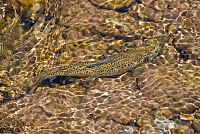| This page uses Creative Commons Licensed content from Wikipedia (view authors). |
The brown trout (Salmo trutta morpha fario and S. trutta morpha lacustris) and the sea trout (S. trutta morpha trutta) are two variants of the same species.
The specific epithet trutta derives from the Latin trutta, meaning, literally, "trout".
The brown trout is normally considered to be native to Europe and Asia.
Conservation status[]
The fish is not considered to be endangered although, in some cases, individual stocks are under various degrees of stress mainly through habitat degradation, overharvest and artificial propagation leading to introgression. Increased frequency of excessively warm water temperatures in high summer, attributedTemplate:By whom to global warmingTemplate:Citation needed, causes a reduction in dissolved oxygen levels which can cause 'summer kills' of local populations if temperatures remain high for sufficient duration and deeper/cooler or fast, turbulent more oxygenated water is not accessible to the fish.
Cover or structure is important to trout, and they are more likely to be found near submerged rocks, undercut banks, and overhanging vegetation. Structure provides protection from predators, bright sunlight and associated high water temperatures. Access to deep water for protection in winter freezes, or fast water for protection from low oxygen levels in summer are also ideal.
Characteristics[]

A young brown trout from the River Derwent in North East England.

Brown trout from a western Wyoming creek.

Brown trout in creek.

Brown trout in Värmland, Sweden, after the first summer.
The brown trout is a medium-sized fish, growing to 20 kg or more in some localities although in many smaller rivers a mature weight of 1 kg (2 lb) or less is common. The spawning behaviour of brown trout is similar to that of the closely related Atlantic salmon. A typical female produces about 2,000 eggs per kilogram (900 eggs per pound) of body weight at spawning.
Brown trout can live to ages of 20 years. But as with the Atlantic salmon, there is a high proportion of death of anadromous males after spawning and probably fewer than 20% of anadromous female kelts recover from spawning. The migratory forms grow to significantly larger sizes for their age due to abundant forage fish in the waters they spend most of their lives. Brown trout are active both by day and by night and are opportunistic feeders. While in fresh water, the diet will frequently include invertebrates from the streambed, other fish, frogs, mice, birds, and insects flying near the water's surface.
Freshwater brown trout range in colour from largely silver with relatively few spots and a white belly, to the more well known brassy brown cast fading to creamy white on the fish's belly, with medium-sized spots surrounded by lighter haloes.
Early stocking efforts in the United States used fish taken from Scotland and Germany. The Loch Leven strain is more often found in the western United States, while the "German brown" is found more toward the Midwest and East.
Diet[]
Young brown trout feed on insects and other invertebrates such as shrimp, flies, caddis, stonefly, mayfly, etc. Both larvae and adults are taken and the fish will eat whatever local insect life is abundant at the time. Larger fish are active predators of fish including young brown trout, suckers, sculpins, shad, whitefish and rainbow trout. Larger brown trout will also feed on small terrestrial animals that fall into the water such as baby birds falling from overhanging nests, or even swimming mice/voles. Brown trout sometimes do not actively feed until the late afternoon or early evening but when the weather is cool they will feed during the day as well. The largest browns feed under cover of darkness.
Stocking, farming and non-native brown trout[]

Exhibition “Subaqueous Vltava”, Prague

Fish in the Faroe Islands:
Brown trout (Salmo trutta fario)
Faroese stamp issued: 7 Feb 1994
Artist: Astrid Andreasen
The species has been widely introduced for purposes of sport into North America, South America, Australia, New Zealand and many other countries including Bhutan where they are the focus of a specialised fly fishery. First planting in the United States occurred April 11, 1884 into the Baldwin River, one mile east of Baldwin, MI.[1] Brown trout have had serious negative impacts on upland native fish species in some of the countries where they have been introduced, particularly Australia.
Because of the trout's importance as a food and game fish, it has been artificially propagated and stocked in many places in its range, and fully natural populations probably exist only in isolated places, for example in Corsica or in high alpine valleys on the European mainland.
Farming of brown trout has included the production of infertile triploid fish by increasing the water temperature just after fertilisation of eggs, or more reliably by a process known as pressure shocking. Triploids are favoured by anglers because they grow faster and larger than diploid trout.
References[]
- ↑ Brown Trout, Salmo trutta Sea Grant. Retrieved 14 February 2010.
Further reading[]
- Clover, Charles. 2004. The End of the Line: How overfishing is changing the world and what we eat. Ebury Press, London. ISBN 0-09-189780-7
External links[]
- Rockford angler Tom Healy hooks 41-pound brown trout that shatters state record Michigan Outdoors, September 10, 2009. mlive.com
- Salmo trutta Linnaeus 1758 GLANSIS Species FactSheet (Distributional information for North America)